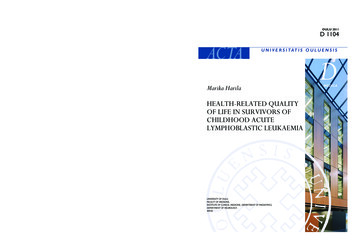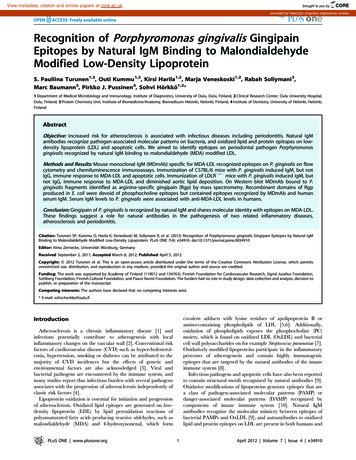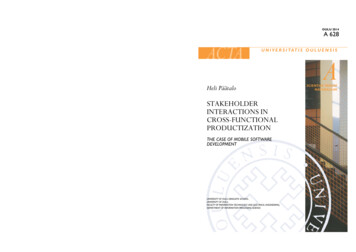
Transcription
A 628OULU 2014UNIV ER S IT Y OF OULU P. O. BR[ 00 FI-90014 UNIVERSITY OF OULU FINLANDU N I V E R S I TAT I SS E R I E SSCIENTIAE RERUM NATURALIUMProfessor Esa HohtolaHUMANIORAUniversity Lecturer Santeri PalviainenTECHNICAPostdoctoral research fellow Sanna TaskilaMEDICAProfessor Olli VuolteenahoSCIENTIAE RERUM SOCIALIUMACTAUNNIIVVEERRSSIITTATATIISS OOUULLUUEENNSSIISSUHeli PäätaloE D I T O R SHeli PäätaloABCDEFGO U L U E N S I SACTAA C TAA 628STAKEHOLDERINTERACTIONS INCROSS-FUNCTIONALPRODUCTIZATIONTHE CASE OF MOBILE SOFTWAREDEVELOPMENTUniversity Lecturer Veli-Matti UlvinenSCRIPTA ACADEMICADirector Sinikka EskelinenOECONOMICAProfessor Jari JugaEDITOR IN CHIEFProfessor Olli VuolteenahoPUBLICATIONS EDITORPublications Editor Kirsti NurkkalaISBN 978-952-62-0513-7 (Paperback)ISBN 978-952-62-0514-4 (PDF)ISSN 0355-3191 (Print)ISSN 1796-220X (Online)UNIVERSITY OF OULU GRADUATE SCHOOL;UNIVERSITY OF OULU,FACULTY OF INFORMATION TECHNOLOGY AND ELECTRICAL ENGINEERING,DEPARTMENT OF INFORMATION PROCESSING SCIENCEASCIENTIAE RERUMRERUMSCIENTIAENATURALIUMNATURALIUM
ACTA UNIVERSITATIS OULUENSISA Scientiae Rerum Naturalium 628HELI PÄÄTALOSTAKEHOLDER INTERACTIONS INCROSS-FUNCTIONALPRODUCTIZATIONThe case of mobile software developmentAcademic dissertation to be presented with the assent ofthe Doctoral Training Committee of Technology andNatural Sciences of the University of Oulu for publicdefence in the OP auditorium (L10), Linnanmaa, on 26September 2014, at 12 noonU N I VE R S I T Y O F O U L U , O U L U 2 0 1 4
Copyright 2014Acta Univ. Oul. A 628, 2014Supervised byProfessor Veikko SeppänenDoctor Juha WarstaReviewed byProfessor Casper LasseniusProfessor Jürgen MünchOpponentProfessor Tomi MännistöISBN 978-952-62-0513-7 (Paperback)ISBN 978-952-62-0514-4 (PDF)ISSN 0355-3191 (Printed)ISSN 1796-220X (Online)Cover DesignRaimo AhonenJUVENES PRINTTAMPERE 2014
Päätalo, Heli, Stakeholder interactions in cross-functional productization. The caseof mobile software developmentUniversity of Oulu Graduate School; University of Oulu, Faculty of Information Technologyand Electrical Engineering, Department of Information Processing ScienceActa Univ. Oul. A 628, 2014University of Oulu, P.O. Box 8000, FI-90014 University of Oulu, FinlandAbstractThis study examines stakeholder interactions in the context of cross-functional softwareproductization. This research aims to increase theoretical and empirical understanding ofinteractions in software productization.The theoretical framework consisted of the stakeholders of software productization, their keyfunctions and the elements of interactions such as communication, collaboration, and integration.The empirical data was gathered through interviews, company documentation and participantobservation in the case organization. The research strategy is a qualitative case study includingsome elements of action research.As the main finding of this study, a model was developed of organization internal stakeholderinteractions in the context of software productization. The model consists of identifiedstakeholders, the elements of interaction and their intensity. In order to create successful softwareproducts, it is increasingly important to acknowledge, consider and meet stakeholders’ views,needs and expectations.According to the findings, the stakeholders are divided into two groups. The first consists ofstakeholders who are responsible for decisions related to the company product portfolio. Thesecond group of stakeholders is focused on software product development and implementation.Within the groups, interaction is intensive, including communication, collaboration andintegration. According to the data, interactions between groups are one-way only and often carriedout via documentation. The stakeholder group responsible for product-related decisions bases itsinteraction on communication which is perceived by the other group as one-way andunreciprocated. This does not promote dialogue between stakeholders, which is essential forachieving common understanding.This study contributes and adds to the limited empirical research on software productization.The new knowledge of stakeholder interactions in cross-functional productization supports projectmanagers in the development of approaches in the understanding of stakeholders’ needs andexpectations. From a managerial viewpoint, this study discusses a number of means which can beused in software productization.Keywords: collaboration, communication, integration, interaction, productization,stakeholder
Päätalo, Heli, Sidosryhmien vuorovaikutus ohjelmistoratkaisujen tuotteistamisessa. Mobiiliratkaisujen tapausOulun yliopiston tutkijakoulu; Oulun yliopisto, Tieto- ja sähkötekniikan tiedekunta,Tietojenkäsittelytieteiden laitosActa Univ. Oul. A 628, 2014Oulun yliopisto, PL 8000, 90014 Oulun yliopistoTiivistelmäTämä tutkimus käsittelee sidosryhmien vuorovaikutusta ohjelmiston tuotteistamisen kontekstissa. Tutkimuksen tavoitteena on lisätä teoreettista ja empiiristä ymmärrystä sidosryhmien vuorovaikutuksesta ohjelmiston tuotteistamisessa.Tutkimuksen teoreettinen viitekehys rakentuu ohjelmistotuotteistamisen sidosryhmistä, niiden funktioista sekä vuorovaikutuksen elementeistä, joita ovat kommunikointi, yhteistyö jaintegrointi ja joiden vuorovaikutusta tarkastellaan. Empiirisenä tutkimusaineistona käytetäänhaastatteluita, tutkimuskohteena olevan organisaation sisäistä dokumentaatiota sekä osallistuvanhavainnoinnin tuloksia. Tutkimus on laadullinen tapaustutkimus, jossa on tiettyjä toimintatutkimuksen aineksia. Tutkimuksen päätuloksena kehitettiin malli organisaation sisäisten sidosryhmien vuorovaikutuksesta ohjelmiston tuotteistamisen näkökulmasta. Malli sisältää tunnistetutsidosryhmät sekä vuorovaikutuksen elementit ja intensiteetin. Sidosryhmien mielipiteiden, näkemysten ja odotusten selvittäminen sekä niihin vastaaminen on onnistuneen ohjelmistotuotteenkannalta yhä tärkeämpää.Aineiston perusteella sidosryhmät jakautuvat kahteen erilliseen ryhmään. Ensimmäiseen kuuluvat ne, jotka päättävät yrityksen tuotevalikoimasta. Toinen ryhmä puolestaan kehittää ja toteuttaa ohjelmistotuotteen. Ryhmien välinen vuorovaikutus on jokseenkin yksisuuntaista ja tapahtuu usein dokumenttien välityksellä. Tuotevalikoimasta päättävän ryhmän vuorovaikutus perustuu kommunikointiin, jonka ohjelmistotuotteen kehittäjien ryhmä kokee yksisuuntaiseksi. Siksise ei käytännössä useinkaan mahdollista vuoropuhelua, jota tarvitaan yhtenäisen ymmärryksensaamiseksi.Tutkimus paljastaa, että sidosryhmien vuorovaikutus on monimutkaisempaa kuin kirjallisuudessa on kuvattu. Se täydentää vielä varsin harvalukuisia tuotteistamiseen liittyviä tutkimuksia.Käytännön suosituksena tutkimus esittää joukon keinoja, joita ohjelmistojen tuotteistamisessavoidaan hyödyntää.Asiasanat: integrointi, kommunikointi, sidosryhmät, tuotteistaminen, vuorovaikutus,yhteistyö
Dedicated to my little sister, Tuija Päätalo
8
AcknowledgementsI would like to present my thanks to Professor Casper Lassenius and ProfessorJürgen Münch, the reviewers of this thesis, for taking the time to analyze and givecritical comments and point out areas of improvement, providing me with achance to develop myself. My warmest thanks to my supervisors, ProfessorVeikko Seppänen and Dr. Juhani Warsta, who guided me from the chaos ofbeginning to the finish line in a firm but always friendly way. I will miss our vividmonthly discussions.I also want to thank Nokia and my former colleagues there for their supportof my studies during these past years, and the interviewees for their time andopenness.I would like to thank my dear friend, Dr. Riitta Laulajainen, who has sharedand acted as a peer group during my journey, and with whom I have been able toshare the moments of accomplishment and downsides of writing this study. Youhave always found some words of encouragement, and as you can see, it hashelped a great deal.Special thanks to my Rottweiler, Kaapo, who has contributed to this thesis bysupervising, making sure that I am at my desk and ensuring that I have taken afew breaks by interrupting me whenever he has found it necessary.Finally, I want to thank my mother Leena, father Matti and my spouse Jyyne.Thank you for standing by me and for your loving support.Kempele, 12.1.2014Heli Päätalo9
10
Table of contentsAbstractTiivistelmäAcknowledgements9Table of contents111 Introduction151.1 Research objectives and motivation . 161.2 Research problem and questions . 191.3 Research approach . 191.4 Prior literature review . 211.4.1 Stakeholder research . 211.4.2 Interactions . 281.4.3 Productization . 321.4.4 Mobile software development . 351.4.5 Conclusions of the literature review . 382 Mobile software development392.1 Mobile market . 392.2 Characteristics of mobile software . 412.2.1 Software product line approach . 432.2.2 Distributed software development . 442.2.3 Open software ecosystems . 462.3 Mobile software product development . 462.4 Stakeholders of software product development . 492.4.1 Marketing . 512.4.2 Corporate management . 532.4.3 Software product management . 552.4.4 Platform development . 622.4.5 Product development . 643 Productization693.1 The concept of productization . 693.2 Conceptual model of productization . 723.3 Productization through modularity . 744 Interaction754.1 Introduction . 754.2 Stakeholder interactions . 754.3 Elements of interaction . 7911
5678124.3.1 Communication . 804.3.2 Collaboration . 824.3.3 Integration. 85Reference framework875.1 The a priori model . 875.1.1 Mobile market needs and opportunities . 905.1.2 Stakeholders . 905.1.3 Cross-functional software productization . 945.1.4 Interactions . 945.2 Summary . 97Research design996.1 Ontology, epistemology and methodology . 996.2 Qualitative case research . 1016.3 Research process and empirical data analysis . 1126.3.1 Research process and empirical data analysis . 1126.3.2 Analysis of the empirical data . 1146.4 Limitations of the research . 1166.5 Summary . 116Analysis of stakeholder interactions in mobile softwareproductization1177.1 The case organization . 1177.2 Cross-functional mobile software productization . 1207.3 Stakeholders of software productization . 1237.4 Interactions in cross-functional software productization . 1367.4.1 Communication . 1367.4.2 Collaboration . 1457.5 Summary . 150Discussion1518.1 Stakeholder interactions in cross-functional softwareproductization . 1518.1.1 Interactions . 1558.1.2 Stakeholders of software productization . 1608.2 Theoretical contributions. 1638.3 Managerial implications . 1688.4 Limitations of the research . 1738.5 Suggestions for future research . 174
9 Conclusions1759.1 Answers to the research questions . 1759.2 Concluding words . 179References181Appendices20713
14
1IntroductionCompanies must be able to manage both their internal and external stakeholdersand stakeholder groups in order to be able to deliver successful products.Numerous stakeholders are involved and impact on a company’s new productdevelopment. They contribute their needs, expectations, knowledge, and supportthrough interacting with product development, but also with each other.Considering and balancing all of the influencing stakeholders’ demands is adifficult task for a product development project manager. If the expectations ofstakeholders are ignored, there is a high risk that the project will not be successful,even if the outcome is delivered within budget, scope, and time (Bourne &Walker 2005). Not much is known about managing multiple stakeholder demandsand issues during new product development, but positive impacts on developmentperformance emerge when stakeholders’ issues are addressed (Driessen &Hillebrand 2010).The competition for mobile device industry market share and the demand forfaster time-to-market has increased drastically. There is an identifiable trend forshortened life cycles in consumer electronics (Minderhout & Fraser 2005)because of technological advances, especially in the mobile phone market (Reineret al. 2009). The need to accelerate the development time has never been greaterand the time seems to constantly shorten (Smith & Reinertsen 1992). Mobiledevice companies aim to achieve the goals of the company and satisfy theirshareholders by increasing their market share through the means of reaching newusers and market segments and providing desirable products which stand out fromtheir competitors. It is characteristic of the mobile branch of the industry that themarket is very demanding and waits impatiently for functional innovations andnew technologies. Thanks to the fast life cycle of mobile devices, it is essentialthat companies have the capability to manage and rapidly respond to changingcustomer needs and wishes. Companies are investing a great deal of resourcesinto seeking means for faster development methods and decision-making in theirR&D development.The purpose of this research is to examine stakeholder interactions in crossfunctional software productization in the context of mobile software development.Nokia will be referred to as a case company. The dissertation is set out as follows:Chapter 1 introduces the research objectives, the research questions, theresearch approach and the literature review related to this topic. The scope of the15
research themes that links stakeholders, interactions and productization isidentified.Chapter 2 introduces the contextual view on mobile software developmentand its characteristics, and serves as a foundation for the following core chapters.Chapter 3 explains the theoretical aspects of productization which are centralcomponents of this research. This chapter provides the overview to thecircumstances of the research problem.Chapter 4 includes a theoretical perspective of interaction and relatedelements.Chapter 5 introduces the reference framework. The established a priori modelis based on Chapters 2, 3 and 4, to guide the data collection and analysis.Chapter 6 explains the research design, and describes the philosophical basisof the research approach, the research strategy, and the empirical techniques.Chapter 7 presents the empirical data and the analysis of stakeholderinteractions in mobile software productization.Chapter 8 discusses the results of this study.Chapter 9 summarizes the answers to the research questions, and themanagerial implications. Directions for future studies of the topic are speculatedupon.1.1Research objectives and motivationCompanies are expected to provide products and solutions to customers guicklyand efficiently (Hänninen et al. 2012). There is an increased need for companiesto address the challenges of the product development such as:––––More effective production of softwareBringing new products to the market more quickly and efficientlyMeeting customer and segment-specific needs more efficientlyGetting new products to the market on time.The effective production of software has been an issue in the mobile deviceindustry for years. The background of this topic lies in the nature of the short lifecycles of mobile devices and the demand for improved capability to bring newproducts faster and more efficiently to the market. If company misses a mobiledevice market window, this will impact seriously on the company’s productivityand market share. Successful product development is critically dependent on theconsideration of stakeholders’ expectations and relationships throughout the16
project life cycle (Bourne & Walker 2005, Cleland 1999). Stakeholders often havehidden power and influence, and they have a crucial impact on productdevelopment success (Bourne & Walker 2005, Yang et al. 2011).Numerous stakeholders must be considered during software productdevelopment. Stakeholders are thought of congruently in the literature as persons,organizations, institutions, societies, neighborhoods, groups, and the naturalenvironment (Mitchell et al. 1997). Today, stakeholders play a significant role inalmost every project’s course of events (Karlsen 2002), and projects areinfluenced by many different stakeholders. Project stakeholders can bedistinguished between stakeholders that are internal (intra-organizational) andexternal to the organization (Pirson & Malhotra 2007). The success of products isdependent on the ability to address stakeholders’ expectations (Bourne & Walker2005). In order to create successful new mobile products, it is essential to identifystakeholders and understand how they interact with each other, and how theyinfluence product development projects.Software productization is a phase of a new product development project inwhich software functionalities and features of the new mobile device are finalizedand integrated as a first commercial version of a software release to the market.Software productization takes place at the end of the mobile device developmentlifecycle. It is typically a phase during which a mass of different stakeholderdemands and expectations, software and functionality related requirements, andchange requests and technology expectations are met. In addition, the project iscompeting against time. The allocated resources are often exceeded, and costlyand difficult decisions must be made when modifying and optimizing the contentof the software release. The forthcoming software release target date createsincreased stakeholder expectations to get as many features as possible included inthe first software release package. Any new software features or functionalitiesadded in the software productization phase increase the risk that the softwareproduct launch schedule targets are not met.The objective of this thesis is to increase understanding of stakeholderinteractions in cross-functional software productization in the context of mobilesoftware development. Mobile software is an essential part of a mobile product.Mobile software productization is an integrative and finalizing phase of mobileproduct development. In practice, it is more complicated than that. At this stage,many stakeholder needs and new software requirements are still coming in fromstakeholders, and balancing and trade-offs need to be accomplished. Thedevelopment of a mobile software product is a cross-functional work effort17
involving influential stakeholders who have interests and sometimes agendas andambitions of their own. Considering and fulfilling the stakeholders’ needs iscrucial in order to create successful software products. However, addressing allneeds equally may not be a good approach, because the software productizationmay end up in a situation where the software product is overloaded with endlesssoftware requirements and, in other words, will never be mature enough for themarket.The motivation of this research is to provide theoretical and empiricalinsights into stakeholder interactions in cross-functional software productizationin the context of mobile software development. The author’s long workexperience in R&D is the second source of motivation. As is the case for manydevelopment companies, it is important to acknowledge stakeholder groups andthe interactions between stakeholders in software productization. Finally, it isimportant to find ways to understand how these interactions could be managed ina more systematic way.The objective has been derived from a mobile device company and the studyis conducted in a large cross-functional R&D product development organization.The capability to accelerate mobile software product development and the abilityto ensure the right timing to the market is in the interests of all of the company’sstakeholders and shareholders. Admitting that with embedded softwaredevelopment, the related hardware and systems are generally considered, they areleft out in this research.Before the mobile software reaches the productization phase, numerous decisionsmust be made and much development work must be done in many organizationunits in the company. The decisions are evaluated from many perspectives,technological, cost, market pull and push, time-to-market and being the first in aparticular technology area by weighting some criteria more than others. Oneviewpoint is that the software product needs to fit the choices and goals of thecompany.The results of this research are also useful for managers, firstly, to providevisibility to the number and types of stakeholders and their interactions insoftware productization which are dealt with every day; and secondly, to increaseawareness of the importance and impact of stakeholder interactions in softwareproductization.18
1.2Research problem and questionsResearch on interactions in cross-functional environments has been focused onstudying cooperation and collaboration across selected functions in the context ofnew product development (Chen 2007, Fain et al. 2011, Fredericks 2005, Gemser& Leenders 2011, Holland et al. 2000, Kim & Kang 2008). This research aims tofill the gap caused by the lack of studies about stakeholder interactions in crossfunctional software productization.A mobile product consists of large software packages. For example, Nokiahas reported that software development costs make up approximately 80% of thetotal mobile phone development costs (Jaakkola 2009). Mobile software productplanning and development is a highly interactive process. Internal companystakeholders are involved in expressing their needs and expectations. During thedevelopment phase, hundreds of people participate in designing and engineeringsoftware components and making numerous decisions. The research questions canbe stated as follows:1.2.3.What stakeholder interactions exist in cross-functional softwareproductization?How do stakeholders associate through interactions in cross-functionalsoftware productization?How could stakeholder interactions be coordinated in cross-functionalsoftware productization?The research questions are related, but their focus is different. The researchoperates on a company level, but is valid even beyond the case company. Theexamination was conducted through a case study in a research company, and thephenomenon under study was investigated through soliciting the views ofmembers of the case company’s software product development organization.Managerial implications were then derived from the research.1.3Research approachThis thesis is based on qualitative research involving a case study consisting oftheoretical and the case company-specific sections. It is characteristic ofqualitative research that the study is conducted in a real-life context, trying tomake sense of or interpret the phenomena (Yin 2009). The case study approachfits particularly with this research, because the topic concerns social and complex19
phenomena (Yin 2009) that occur in interactions. The case study is often used tounderstand the dynamics within a single scenario (Eisenhardt 1989), and thisapproach is adopted in this study, too. The research questions of this thesis focuson identifying stakeholder interactions from a cross-functional mobile softwareproductization perspective and explaining the contextual impact of thoseinteractions. As stated by Yin (2009), the case study method is useful in theresearch of contextual conditions.The company-specific data was collected through open interviews,participating observation, and company documentation. This combined datacollection method when using a case study approach is advocated by Eisenhardt(1989) and Yin (2009). The use of multiple sources converging the facts andfindings increases the quality of the case study. The informants were selectedamong experienced senior managers of the case company to investigate theirsubjective perspectives. An overview of the research process and the major steps,according to Niiniluoto (1999), are presented in Figure 1.Needs, requirements,constraints placed onorganizationResearch processFormulation of research questionFormulation of research strategyConstraintsSelection of research methodsof the research questionsData gatheringData analysisDiscussion and conclusionsManagerial implicationsplaced on organizationContribution to scienceFig. 1. Research process overview and major steps (based on Niiniluoto 1999).20
The research was carried out in parallel with the author s work in the casecompany, dealing with real-life projects and in close cooperation withpractitioners in product development projects in software productizationsituations. The theory section was carried out by reviewing the area of researchthrough the means of analyzing related studies.1.4Prior literature reviewThis section provides an introduction to the extant literature carried out on topicsrelevant to the theoretical basis of this study. The structure of this literaturereview is composed as follows. Section 1.4.1 provides an overview of previousstakeholder studies relevant to this research in order to expose the concept itself,and the background of stakeholder thinking and how stakeholders may influencecompany and product development. Interaction-related research is visited inSection 1.4.2. Section 1.4.3 introduces studies in the productization field andSection 1.4.4 provides a view of mobile software development research.1.4.1 Stakeholder researchStakeholder theory has been a great topic of interest and has been studied fromnumerous perspectives since the 1980s. The pioneering work of stakeholdertheory was introduced by Freeman (1984) in his book, Strategic management: Astakeholder approach, which described the idea of companies havingstakeholders with characteristic features. Freeman’s essential study has been abasis for many other stakeholder scholars, and stakeholder theory has beenapplied in different business contexts (Fassin 2008, Friedman & Miles 2002,Mitchell et al. 1997, Post et al. 2002, Rowley 1997). Donaldson and Preston(1995) extended the stakeholder model to define and explain the concept oflegitimate stakeholders, which should be seen as part of a company’s environment,having an impact on its activities.The roots of stakeholder theory lie in organization theory and organizationalstrategy (Yläranta 2006). The primary idea of stakeholder theory is tha
The competition for mobile device industry market share and the demand for faster time-to-market has increased drastically. There is an identifiable trend for shortened life cycles in consumer electronics (Minderhout & Fraser 2005) because of technological advances, especially in the mobile phone market (Reiner et al. 2009). The need to .


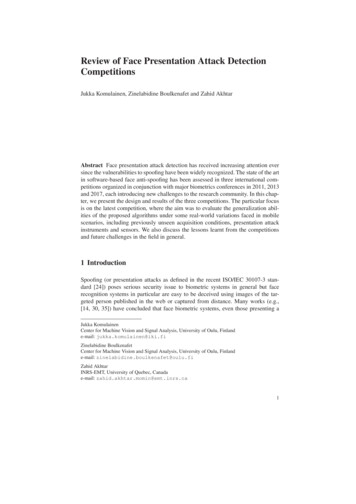
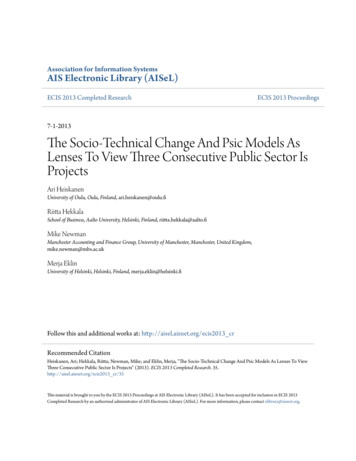
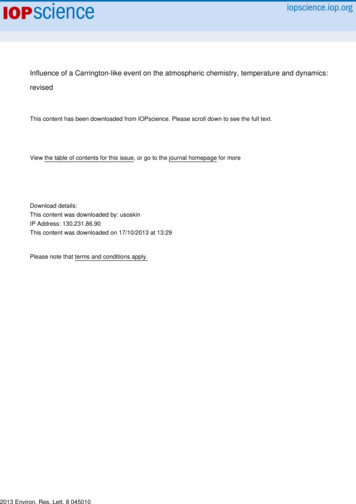


![arXiv:1208.1409v1 [astro-ph.CO] 7 Aug 2012](/img/28/pp12055.jpg)
